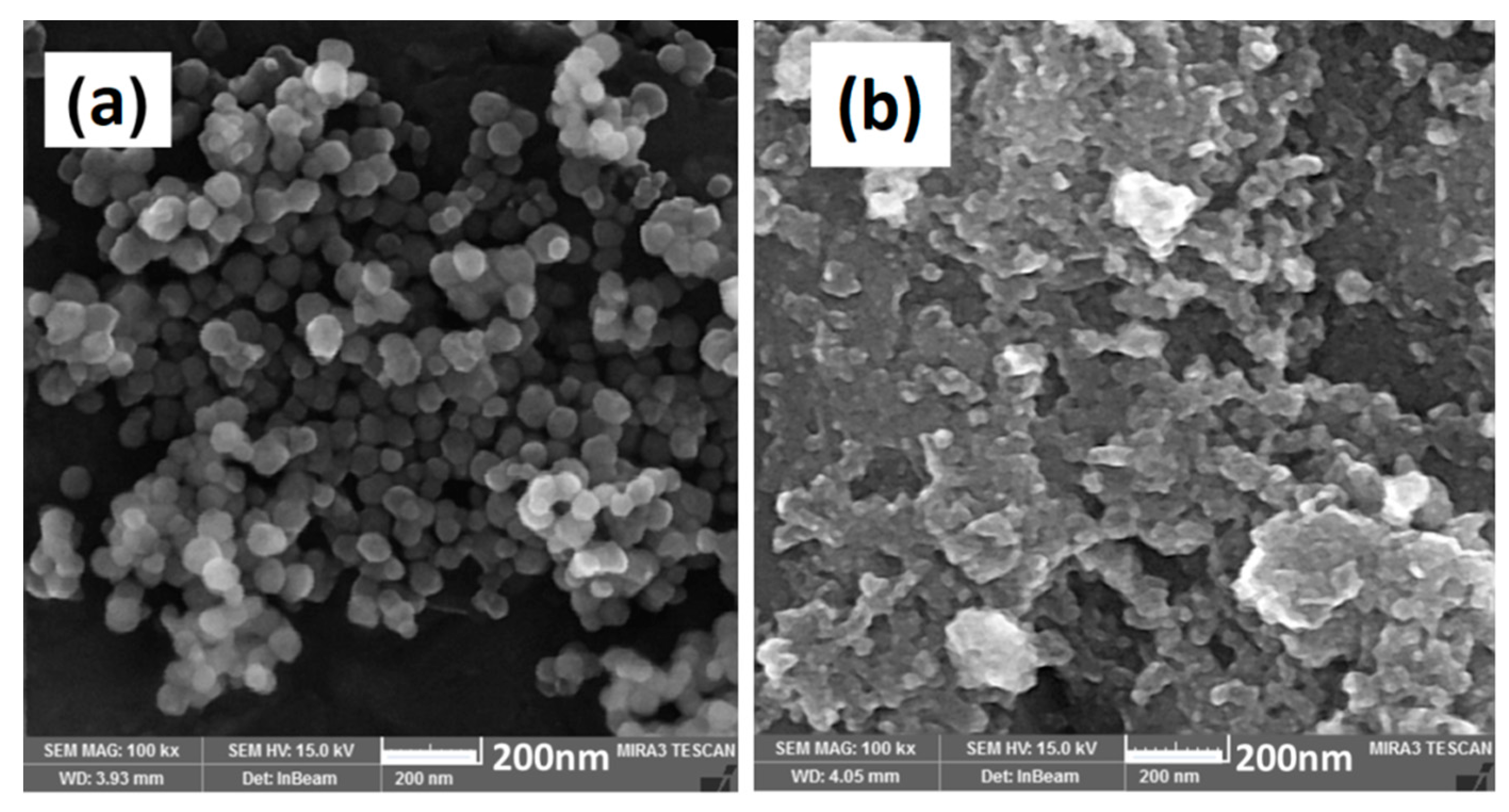Thermal Analysis of Crosslinking Reactions in Epoxy Nanocomposites Containing Polyvinyl Chloride (PVC)-Functionalized Nickel-Doped Nano-Fe3O4
Abstract
1. Introduction
2. Experimental
2.1. Materials
2.2. Methods
3. Results and Discussion
3.1. Structure and Morphology
3.2. Cure Analysis
3.2.1. Qualitative Cure Analysis Based on Cure Index
3.2.2. Quantitative Cure Analysis
Cure Behavior
Cure Kinetics
Estimation of the Kinetics Model
Determination of the kinetics parameters
Model validation
4. Conclusions
Author Contributions
Funding
Conflicts of Interest
Appendix A. Isoconversional Kinetic Methods
Appendix A.1. Friedman Model

Appendix A.2. KAS Method

Appendix B. Selection of Curing Reaction Model
Appendix B.1. Friedman Model

Appendix C. Determination of Degree of Reaction
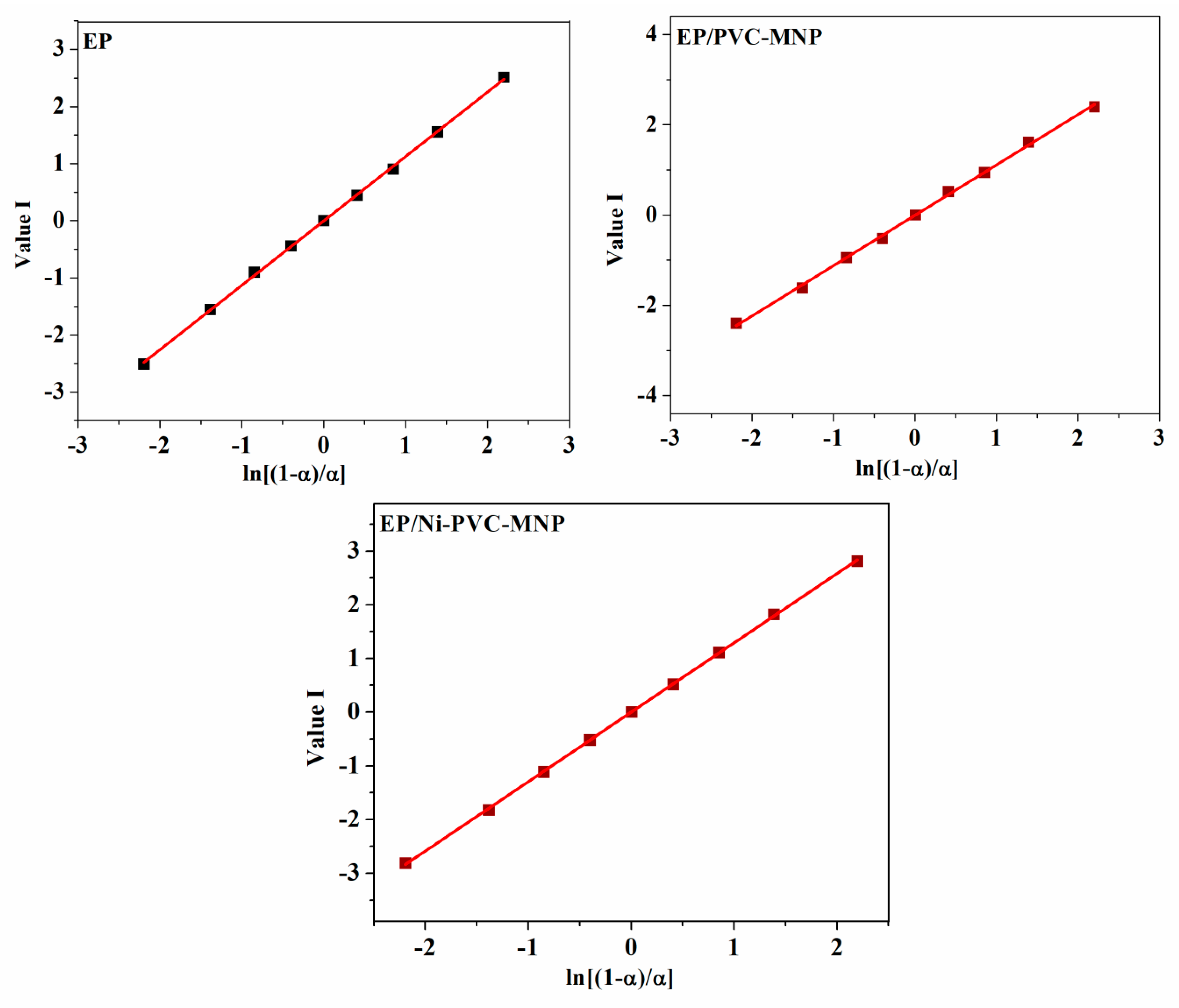

References
- Bisht, A.; Dasgupta, K.; Lahiri, D. Evaluating the effect of addition of nanodiamond on the synergistic effect of graphene-carbon nanotube hybrid on the mechanical properties of epoxy based composites. Polym. Test. 2020, 81, 106274. [Google Scholar] [CrossRef]
- Jouyandeh, M.; Moini Jazani, O.; Navarchian, A.H.; Saeb, M.R. High-performance epoxy-based adhesives reinforced with alumina and silica for carbon fiber composite/steel bonded joints. J. Reinf. Plast. Compos. 2016, 35, 1685–1695. [Google Scholar] [CrossRef]
- Jouyandeh, M.; Jazani, O.M.; Navarchian, A.H.; Shabanian, M.; Vahabi, H.; Saeb, M.R. Bushy-surface hybrid nanoparticles for developing epoxy superadhesives. Appl. Surf. Sci. 2019, 479, 1148–1160. [Google Scholar] [CrossRef]
- Vahabi, H.; Jouyandeh, M.; Cochez, M.; Khalili, R.; Vagner, C.; Ferriol, M.; Movahedifar, E.; Ramezanzadeh, B.; Rostami, M.; Ranjbar, Z.; et al. Short-lasting fire in partially and completely cured epoxy coatings containing expandable graphite and halloysite nanotube additives. Prog. Org. Coat. 2018, 123, 160–167. [Google Scholar] [CrossRef]
- Talo, A.; Passiniemi, P.; Forsen, O.; Yläsaari, S. Polyaniline/epoxy coatings with good anti-corrosion properties. Synth. Met. 1997, 85, 1333–1334. [Google Scholar] [CrossRef]
- Saeb, M.R.; Najafi, F.; Bakhshandeh, E.; Khonakdar, H.A.; Mostafaiyan, M.; Simon, F.; Scheffler, C.; Mäder, E. Highly curable epoxy/MWCNTs nanocomposites: An effective approach to functionalization of carbon nanotubes. Chem. Eng. J. 2015, 259, 117–125. [Google Scholar] [CrossRef]
- Jouyandeh, M.; Yarahmadi, E.; Didehban, K.; Ghiyasi, S.; Paran, S.M.R.; Puglia, D.; Ali, J.A.; Jannesari, A.; Saeb, M.R.; Ranjbar, Z.; et al. Cure kinetics of epoxy/graphene oxide (GO) nanocomposites: Effect of starch functionalization of GO nanosheets. Prog. Org. Coat. 2019, 136, 105217. [Google Scholar] [CrossRef]
- Kornmann, X.; Lindberg, H.; Berglund, L.A. Synthesis of epoxy–clay nanocomposites: Influence of the nature of the clay on structure. Polymer 2001, 42, 1303–1310. [Google Scholar] [CrossRef]
- Jouyandeh, M.; Jazani, O.M.; Navarchian, A.H.; Shabanian, M.; Vahabi, H.; Saeb, M.R. Surface engineering of nanoparticles with macromolecules for epoxy curing: Development of super-reactive nitrogen-rich nanosilica through surface chemistry manipulation. Appl. Surf. Sci. 2018, 447, 152–164. [Google Scholar] [CrossRef]
- Akbari, V.; Najafi, F.; Vahabi, H.; Jouyandeh, M.; Badawi, M.; Morisset, S.; Ganjali, M.R.; Saeb, M.R. Surface chemistry of halloysite nanotubes controls the curability of low filled epoxy nanocomposites. Prog. Org. Coat. 2019, 135, 555–564. [Google Scholar] [CrossRef]
- Karami, Z.; Jouyandeh, M.; Ali, J.A.; Ganjali, M.R.; Aghazadeh, M.; Maadani, M.; Rallini, M.; Luzi, F.; Torre, L.; Puglia, D.; et al. Cure Index for labeling curing potential of epoxy/LDH nanocomposites: A case study on nitrate anion intercalated Ni-Al-LDH. Prog. Org. Coat. 2019, 136, 105228. [Google Scholar] [CrossRef]
- Karami, Z.; Jouyandeh, M.; Ali, J.A.; Ganjali, M.R.; Aghazadeh, M.; Paran, S.M.R.; Naderi, G.; Puglia, D.; Saeb, M.R. Epoxy/layered double hydroxide (LDH) nanocomposites: Synthesis, characterization, and Excellent cure feature of nitrate anion intercalated Zn-Al LDH. Prog. Org. Coat. 2019, 136, 105218. [Google Scholar] [CrossRef]
- Karami, Z.; Jouyandeh, M.; Ali, J.A.; Ganjali, M.R.; Aghazadeh, M.; Maadani, M.; Rallini, M.; Luzi, F.; Torre, L.; Puglia, D.; et al. Development of Mg-Zn-Al-CO3 ternary LDH and its curability in epoxy/amine system. Prog. Org. Coat. 2019, 136, 105264. [Google Scholar] [CrossRef]
- Jouyandeh, M.; Tikhani, F.; Shabanian, M.; Movahedi, F.; Moghari, S.; Akbari, V.; Gabrion, X.; Laheurte, P.; Vahabi, H.; Saeb, M.R. Synthesis, characterization, and high potential of 3D metal–organic framework (MOF) nanoparticles for curing with epoxy. J. Alloy. Compd. 2020, 829, 154547. [Google Scholar] [CrossRef]
- Wang, N.; Zhang, Y.; Chen, J.; Zhang, J.; Fang, Q. Dopamine modified metal-organic frameworks on anti-corrosion properties of waterborne epoxy coatings. Prog. Org. Coat. 2017, 109, 126–134. [Google Scholar] [CrossRef]
- Jouyandeh, M.; Paran, S.M.R.; Shabanian, M.; Ghiyasi, S.; Vahabi, H.; Badawi, M.; Formela, K.; Puglia, D.; Saeb, M.R. Curing behavior of epoxy/Fe3O4 nanocomposites: A comparison between the effects of bare Fe3O4, Fe3O4/SiO2/chitosan and Fe3O4/SiO2/chitosan/imide/phenylalanine-modified nanofillers. Prog. Org. Coat. 2018, 123, 10–19. [Google Scholar] [CrossRef]
- Jouyandeh, M.; Shabanian, M.; Khaleghi, M.; Paran, S.M.R.; Ghiyasi, S.; Vahabi, H.; Formela, K.; Puglia, D.; Saeb, M.R. Acid-aided epoxy-amine curing reaction as reflected in epoxy/Fe3O4 nanocomposites: Chemistry, mechanism, and fracture behavior. Prog. Org. Coat. 2018, 125, 384–392. [Google Scholar] [CrossRef]
- Wang, L.; Qiu, H.; Liang, C.; Song, P.; Han, Y.; Han, Y.; Gu, J.; Kong, J.; Pan, D.; Guo, Z. Electromagnetic interference shielding MWCNT-Fe3O4@ Ag/epoxy nanocomposites with satisfactory thermal conductivity and high thermal stability. Carbon 2019, 141, 506–514. [Google Scholar] [CrossRef]
- Huangfu, Y.; Liang, C.; Han, Y.; Qiu, H.; Song, P.; Wang, L.; Kong, J.; Gu, J. Fabrication and investigation on the Fe3O4/thermally annealed graphene aerogel/epoxy electromagnetic interference shielding nanocomposites. Compos. Sci. Technol. 2019, 169, 70–75. [Google Scholar] [CrossRef]
- Saeb, M.R.; Bakhshandeh, E.; Khonakdar, H.A.; Mäder, E.; Scheffler, C.; Heinrich, G. Cure kinetics of epoxy nanocomposites affected by MWCNTs functionalization: A review. Sci. World J. 2013, 2013, 1–14. [Google Scholar] [CrossRef]
- Jouyandeh, M.; Ganjali, M.R.; Ali, J.A.; Aghazadeh, M.; Stadler, F.J.; Saeb, M.R. Curing epoxy with electrochemically synthesized MnxFe3-xO4 magnetic nanoparticles. Prog. Org. Coat. 2019, 136, 105199. [Google Scholar] [CrossRef]
- Jouyandeh, M.; Ali, J.A.; Aghazadeh, M.; Formela, K.; Saeb, M.R.; Ranjbar, Z.; Ganjali, M.R. Curing epoxy with electrochemically synthesized ZnxFe3-xO4 magnetic nanoparticles. Prog. Org. Coat. 2019, 136, 105246. [Google Scholar] [CrossRef]
- Fu, Z.; Yang, B.; Zhang, Y.; Zhang, N.; Yang, Z. Dopant segregation and CO adsorption on doped Fe3O4 (1 1 1) surfaces: A first-principle study. J. Catal. 2018, 364, 291–296. [Google Scholar] [CrossRef]
- Jouyandeh, M.; Ganjali, M.R.; Ali, J.A.; Aghazadeh, M.; Stadler, F.J.; Saeb, M.R. Curing epoxy with electrochemically synthesized NixFe3-xO4 magnetic nanoparticles. Prog. Org. Coat. 2019, 136, 105198. [Google Scholar] [CrossRef]
- Jouyandeh, M.; Zarrintaj, P.; Ganjali, M.R.; Ali, J.A.; Karimzadeh, I.; Aghazadeh, M.; Ghaffari, M.; Saeb, M.R. Curing epoxy with electrochemically synthesized GdxFe3-xO4 magnetic nanoparticles. Prog. Org. Coat. 2019, 136, 105245. [Google Scholar] [CrossRef]
- Jouyandeh, M.; Ganjali, M.R.; Ali, J.A.; Aghazadeh, M.; Stadler, F.J.; Saeb, M.R. Curing epoxy with electrochemically synthesized CoxFe3-xO4 magnetic nanoparticles. Prog. Org. Coat. 2019, 137, 105252. [Google Scholar] [CrossRef]
- Jouyandeh, M.; Ganjali, M.R.; Ali, J.A.; Aghazadeh, M.; Saeb, M.R.; Ray, S.S. Curing epoxy with polyvinylpyrrolidone (PVP) surface-functionalized NixFe3-xO4 magnetic nanoparticles. Prog. Org. Coat. 2019, 136, 105259. [Google Scholar] [CrossRef]
- Jouyandeh, M.; Ganjali, M.R.; Ali, J.A.; Aghazadeh, M.; Paran, S.M.R.; Naderi, G.; Saeb, M.R.; Thomas, S. Curing epoxy with polyvinylpyrrolidone (PVP) surface-functionalized ZnxFe3-xO4 magnetic nanoparticles. Prog. Org. Coat. 2019, 136, 105227. [Google Scholar] [CrossRef]
- Jouyandeh, M.; Ali, J.A.; Akbari, V.; Aghazadeh, M.; Paran, S.M.R.; Naderi, G.; Saeb, M.R.; Ranjbar, Z.; Ganjali, M.R. Curing epoxy with polyvinylpyrrolidone (PVP) surface-functionalized MnxFe3-xO4 magnetic nanoparticles. Prog. Org. Coat. 2019, 136, 105247. [Google Scholar] [CrossRef]
- Jouyandeh, M.; Ganjali, M.R.; Ali, J.A.; Aghazadeh, M.; Karimzadeh, I.; Formela, K.; Colom, X.; Cañavate, J.; Saeb, M.R. Curing epoxy with ethylenediaminetetraacetic acid (EDTA) surface-functionalized CoxFe3-xO4 magnetic nanoparticles. Prog. Org. Coat. 2019, 136, 105248. [Google Scholar] [CrossRef]
- Jouyandeh, M.; Ganjali, M.R.; Ali, J.A.; Akbari, V.; Karami, Z.; Aghazadeh, M.; Zarrintaj, P.; Saeb, M.R. Curing epoxy with polyethylene glycol (PEG) surface-functionalized GdxFe3-xO4 magnetic nanoparticles. Prog. Org. Coat. 2019, 137, 105283. [Google Scholar] [CrossRef]
- Jouyandeh, M.; Hamad, S.M.; Karimzadeh, I.; Aghazadeh, M.; Karami, Z.; Akbari, V.; Shammiry, F.; Formela, K.; Saeb, M.R.; Ranjbar, Z.; et al. Unconditionally blue: Curing epoxy with polyethylene glycol (PEG) surface-functionalized ZnxFe3-xO4 magnetic nanoparticles. Prog. Org. Coat. 2019, 137, 105285. [Google Scholar] [CrossRef]
- Jouyandeh, M.; Karami, Z.; Ali, J.A.; Karimzadeh, I.; Aghazadeh, M.; Laoutid, F.; Vahabi, H.; Saeb, M.R.; Ganjali, M.R.; Dubois, P. Curing epoxy with polyethylene glycol (PEG) surface-functionalized NixFe3-xO4magnetic nanoparticles. Prog. Org. Coat. 2019, 136, 105250. [Google Scholar] [CrossRef]
- Aghazadeh, M.; Ganjali, M.R. One-step electro-synthesis of Ni 2+ doped magnetite nanoparticles and study of their supercapacitive and superparamagnetic behaviors. J. Mater. Sci. Mater. Electron. 2018, 29, 4981–4991. [Google Scholar] [CrossRef]
- Karimzadeh, I.; Dizaji, H.R.; Aghazadeh, M. Development of a facile and effective electrochemical strategy for preparation of iron oxides (Fe3O4 and γ-Fe2O3) nanoparticles from aqueous and ethanol mediums and in situ PVC coating of Fe3O4 superparamagnetic nanoparticles for biomedical applications. J. Magn. Magn. Mater. 2016, 416, 81–88. [Google Scholar] [CrossRef]
- Aghazadeh, M.; Yavari, K. Galvanostatic Deposition of Magnetite Nanoparticles for Biomedical Applications: Simple Preparation and Surface Modification with Polyethylenimine and Polyvinyl Chloride. Anal. Bioanal. Electrochem. 2018, 10, 1426–1436. [Google Scholar]
- Aghazadeh, M.; Karimzadeh, I. One-pot electro-synthesis and characterization of chitosan capped superparamagnetic Iron oxide nanoparticles (SPIONs) from ethanol media. Curr. Nanosci. 2018, 14, 42–49. [Google Scholar] [CrossRef]
- Aghazadeh, M.; Karimzadeh, I.; Ganjali, M.R. Preparation of Nano-sized Bismuth-Doped Fe 3 O 4 as an Excellent Magnetic Material for Supercapacitor Electrodes. J. Electron. Mater. 2018, 47, 3026–3036. [Google Scholar] [CrossRef]
- Aghazadeh, M.; Ganjali, M.R. Evaluation of supercapacitive and magnetic properties of Fe3O4 nano-particles electrochemically doped with dysprosium cations: Development of a novel iron-based electrode. Ceram. Int. 2018, 44, 520–529. [Google Scholar] [CrossRef]
- Aghazadeh, M. One-step cathodic electrosynthesis of surface capped Fe3O4 ultra-fine nanoparticles from ethanol medium without using coating agent. Mater. Lett. 2018, 211, 225–229. [Google Scholar] [CrossRef]
- Tikhani, F.; Moghari, S.; Jouyandeh, M.; Laoutid, F.; Vahabi, H.; Saeb, M.R.; Dubois, P. Curing Kinetics and Thermal Stability of Epoxy Composites Containing Newly Obtained Nano-Scale Aluminum Hypophosphite (AlPO2). Polymers 2020, 12, 644. [Google Scholar] [CrossRef]
- Ručigaj, A.; Kovačič, Ž.; Štirn, Ž.; Krajnc, M. The joint effect of amine and maleimide functional group in aminomaleimide on the curing kinetics and mechanical properties of epoxy resins. Thermochim. Acta 2020, 690, 178668. [Google Scholar] [CrossRef]
- Xie, W.; Huang, S.; Tang, D.; Liu, S.; Zhao, J. Biomass-derived Schiff base compound enabled fire-safe epoxy thermoset with excellent mechanical properties and high glass transition temperature. Chem. Eng. J. 2019, 394, 123667. [Google Scholar] [CrossRef]
- Boonlert-uthai, T.; Samthong, C.; Somwangthanaroj, A. Synthesis, thermal properties and curing kinetics of hyperbranched BPA/PEG epoxy resin. Polymers 2019, 11, 1545. [Google Scholar] [CrossRef] [PubMed]
- Jouyandeh, M.; Ganjali, M.R.; Hadavand, B.S.; Aghazadeh, M.; Akbari, V.; Shammiry, F.; Saeb, M.R. Curing epoxy with polyvinyl chloride (PVC) surface-functionalized CoxFe3-xO4 nanoparticles. Prog. Org. Coat. 2019, 137, 105364. [Google Scholar] [CrossRef]
- Jouyandeh, M.; Tikhani, F.; Hampp, N.; Yazdi, D.A.; Zarrintaj, P.; Ganjali, M.R.; Saeb, M.R. Highly curable self-healing vitrimer-like cellulose-modified halloysite nanotube/epoxy nanocomposite coatings. Chem. Eng. J. 2020, 396, 125196. [Google Scholar] [CrossRef]
- Kieffer, A.; Hartwig, A. Interphase reaction of isocyanates with epoxy resins containing functional groups of different reactivity. Macromol. Mater. Eng. 2001, 286, 254–259. [Google Scholar] [CrossRef]
- Rabearison, N.; Jochum, C.; Grandidier, J.-C. A cure kinetics, diffusion controlled and temperature dependent, identification of the Araldite LY556 epoxy. J. Mater. Sci. 2011, 46, 787–796. [Google Scholar] [CrossRef]
- Ručigaj, A.; Alič, B.; Krajnc, M.; Šebenik, U. Curing of bisphenol A-aniline based benzoxazine using phenolic, amino and mercapto accelerators. Express Polym. Lett. 2015, 9, 647–657. [Google Scholar] [CrossRef]
- Jouyandeh, M.; Karami, Z.; Hamad, S.M.; Ganjali, M.R.; Akbari, V.; Vahabi, H.; Kim, S.-J.; Zarrintaj, P.; Saeb, M.R. Nonisothermal cure kinetics of epoxy/ZnxFe3-xO4 nanocomposites. Prog. Org. Coat. 2019, 136, 105290. [Google Scholar] [CrossRef]
- Jouyandeh, M.; Paran, S.M.R.; Khadem, S.S.M.; Ganjali, M.R.; Akbari, V.; Vahabi, H.; Saeb, M.R. Nonisothermal cure kinetics of epoxy/MnxFe3-xO4 nanocomposites. Prog. Org. Coat. 2020, 140, 105505. [Google Scholar] [CrossRef]
- Van Assche, G.; Verdonck, E.; Van Mele, B. Interrelations between mechanism, kinetics, and rheology in an isothermal cross-linking chain-growth copolymerisation. Polymer 2001, 42, 2959–2968. [Google Scholar] [CrossRef]
- Vyazovkin, S.; Burnham, A.K.; Criado, J.M.; Pérez-Maqueda, L.A.; Popescu, C.; Sbirrazzuoli, N. ICTAC Kinetics Committee recommendations for performing kinetic computations on thermal analysis data. Thermochim. Acta 2011, 520, 1–19. [Google Scholar] [CrossRef]
- Song, Y.; Liu, M.; Zhang, L.; Mu, C.; Hu, X. Mechanistic interpretation of the curing kinetics of tetra-functional cyclosiloxanes. Chem. Eng. J. 2017, 328, 274–279. [Google Scholar] [CrossRef]
- Akbari, V.; Jouyandeh, M.; Paran, S.M.R.; Ganjali, M.R.; Abdollahi, H.; Vahabi, H.; Ahmadi, Z.; Formela, K.; Esmaeili, A.; Mohaddespour, A. Effect of Surface Treatment of Halloysite Nanotubes (HNTs) on the Kinetics of Epoxy Resin Cure with Amines. Polymers 2020, 12, 930. [Google Scholar] [CrossRef] [PubMed]
- Ratna, D. Handbook of Thermoset Resins; Ismithers: Shawbury, UK, 2009. [Google Scholar]
- Corezzi, S.; Fioretto, D.; Santucci, G.; Kenny, J.M. Modeling diffusion-control in the cure kinetics of epoxy-amine thermoset resins: An approach based on configurational entropy. Polymer 2010, 51, 5833–5845. [Google Scholar] [CrossRef]
- Gotor, F.J.; Criado, J.M.; Malek, J.; Koga, N. Kinetic analysis of solid-state reactions: The universality of master plots for analyzing isothermal and nonisothermal experiments. J. Phys. Chem. A 2000, 104, 10777–10782. [Google Scholar] [CrossRef]
- Criado, J.; Malek, J.; Ortega, A. Applicability of the master plots in kinetic analysis of non-isothermal data. Thermochim. Acta 1989, 147, 377–385. [Google Scholar] [CrossRef]

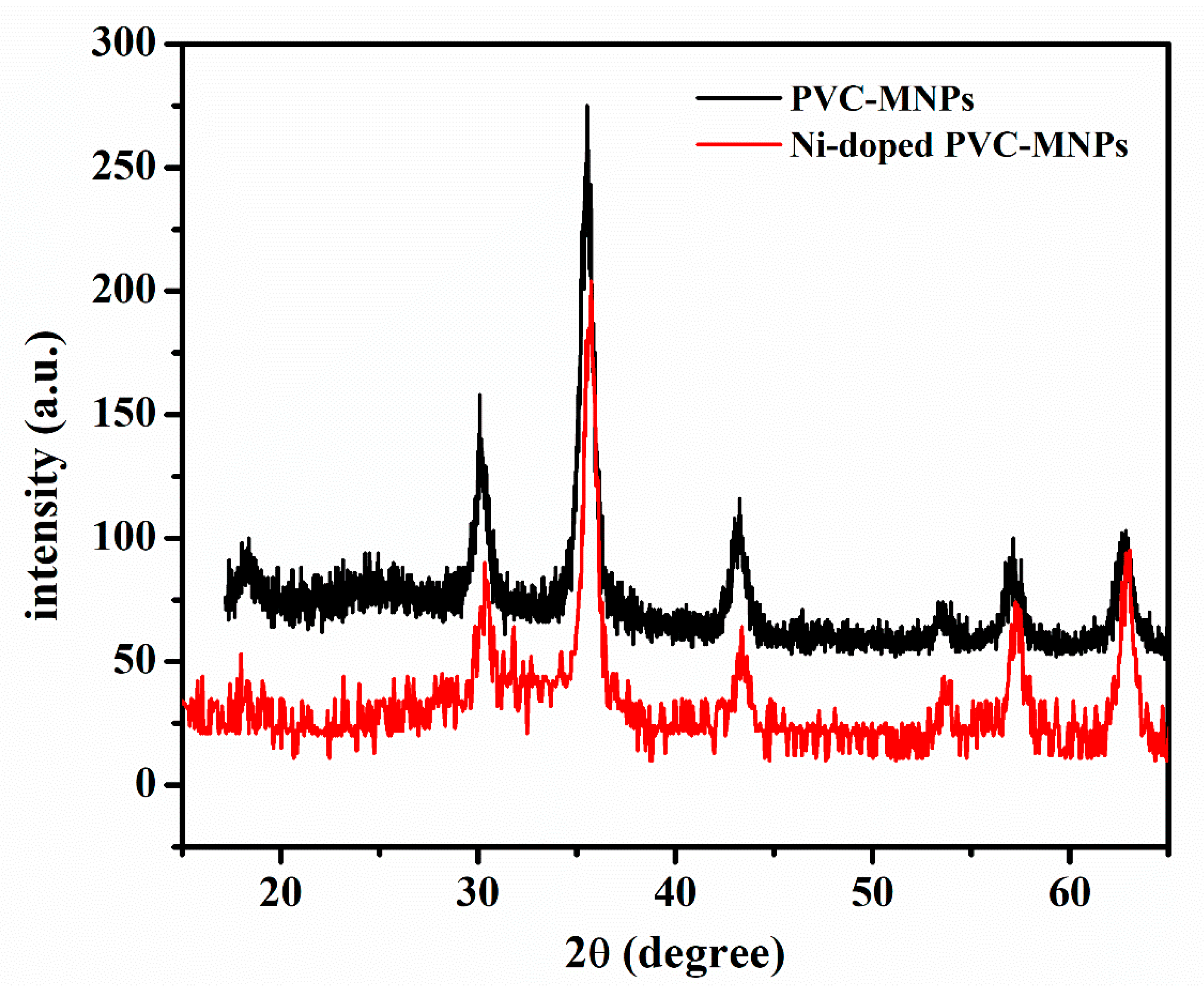
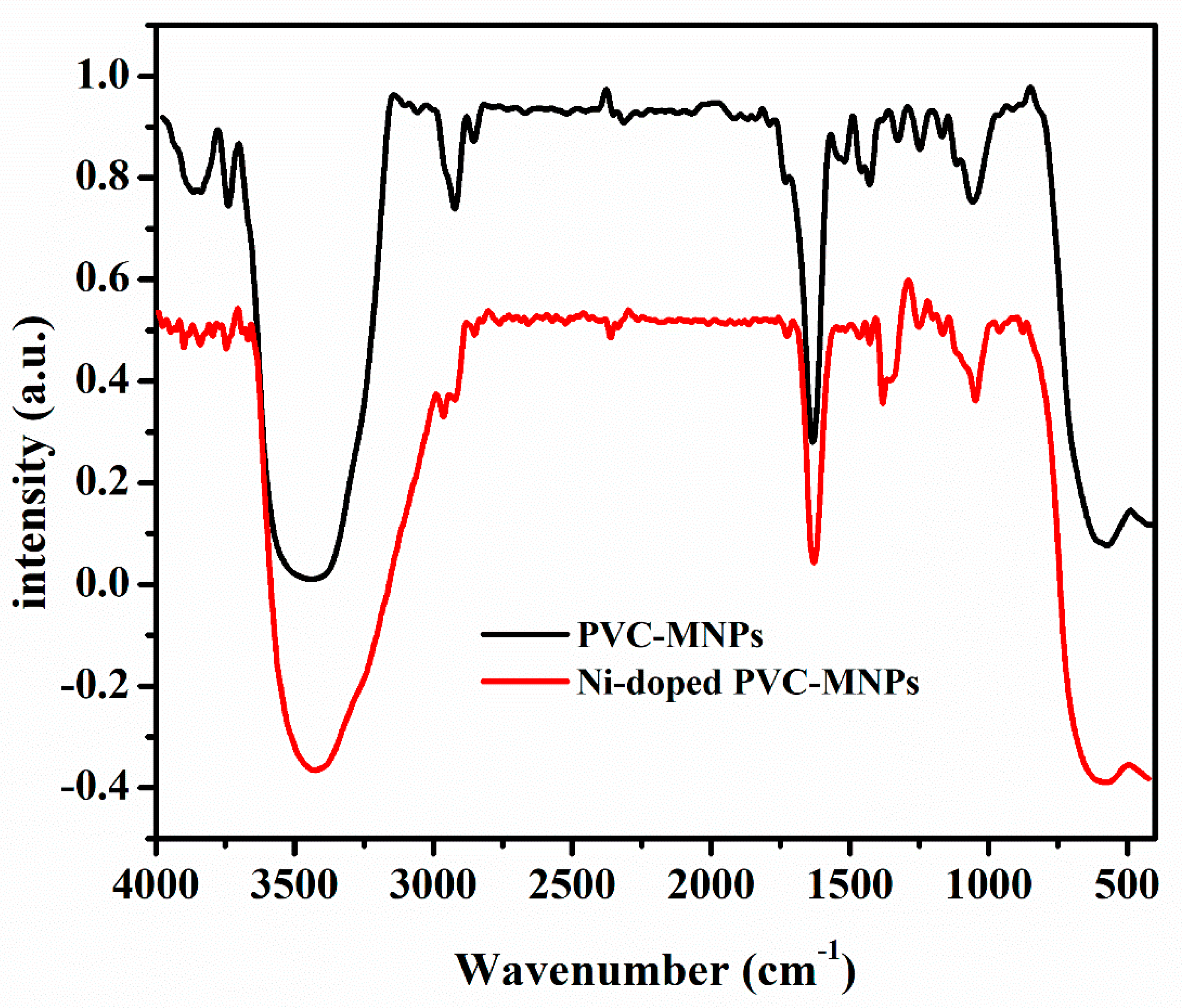



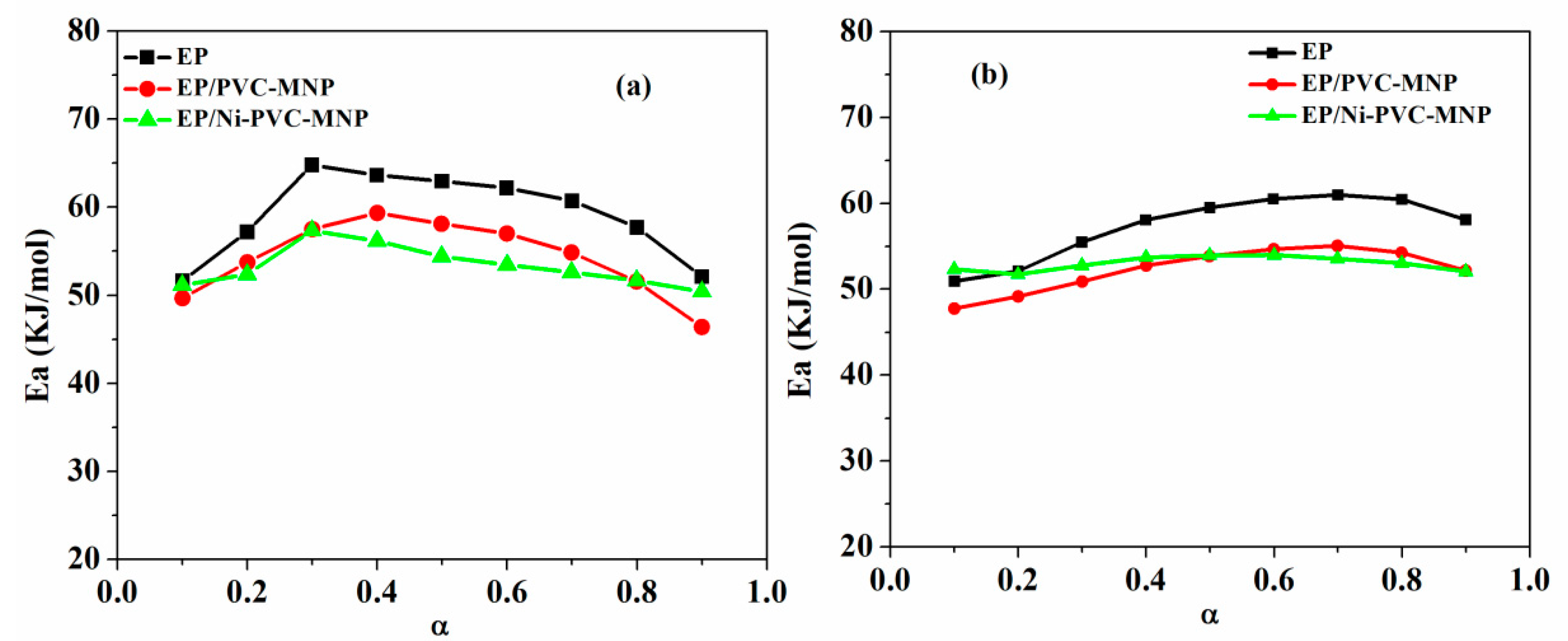


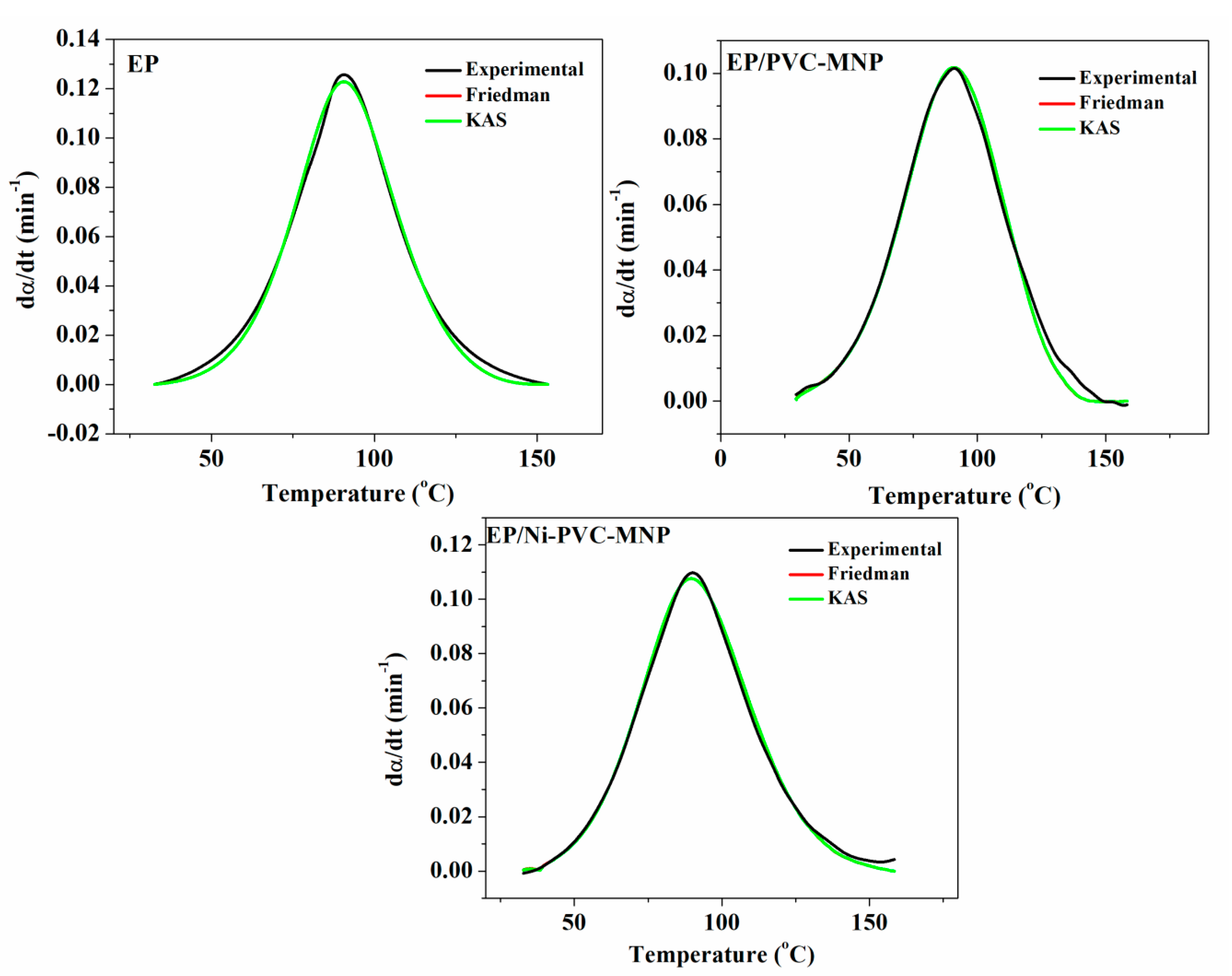
| Sample Codes | β (°C/min) | Tonset (°C) | Tendset (°C) | Tp (°C) | ΔT (°C) | ΔH∞ (J/g) |
|---|---|---|---|---|---|---|
| EP [45] | 5 | 30.04 | 107.62 | 75.31 | 77.58 | 340.41 |
| 10 | 29.70 | 165.3 | 98.4 | 135.7 | 319.40 | |
| 15 | 36.64 | 191.89 | 107.89 | 155.25 | 377.61 | |
| 20 | 38.62 | 146.67 | 96.09 | 108.05 | 374.39 | |
| EP/PVC–MNPs [45] | 5 | 29.34 | 158.34 | 91.06 | 129.00 | 278.98 |
| 10 | 32.07 | 193.94 | 100.17 | 161.86 | 513.07 | |
| 15 | 39.75 | 202.78 | 108.11 | 163.02 | 532.54 | |
| 20 | 39.04 | 212.07 | 115.47 | 173.03 | 387.40 | |
| EP/Ni-doped PVC–MNPs | 5 | 32.72 | 158.48 | 90.06 | 125.76 | 354.05 |
| 10 | 33.43 | 183.09 | 102.30 | 149.66 | 353.49 | |
| 15 | 40.38 | 192.87 | 108.96 | 152.50 | 339.31 | |
| 20 | 42.19 | 205.52 | 115.30 | 163.33 | 354.92 |
| Designation | β (°C/min) | ΔT* | ΔH* | CI | Quality |
| EP/PVC–MNPs [45] | 5 | 1.66 | 0.82 | 1.36 | Poor |
| 10 | 1.19 | 1.61 | 1.92 | Good | |
| 15 | 1.05 | 1.41 | 1.48 | Good | |
| 20 | 1.60 | 1.03 | 1.65 | Good | |
| EP/Ni–PVC–MNPs | 5 | 1.62 | 1.04 | 1.68 | Good |
| 10 | 1.10 | 1.11 | 1.22 | Good | |
| 15 | 0.98 | 0.90 | 0.88 | Poor | |
| 20 | 1.51 | 0.95 | 1.43 | Poor |
| Designation | Heating Rate (°C/min) | αp∞ | αm | αp |
|---|---|---|---|---|
| EP | 5 | 0.487 | 0.144 | 0.512 |
| 10 | 0.555 | 0.073 | 0.510 | |
| 15 | 0.418 | 0.236 | 0.498 | |
| 20 | 0.383 | 0.251 | 0.483 | |
| EP/PVC–MNP | 5 | 0.505 | 0.061 | 0.527 |
| 10 | 0.360 | 0.091 | 0.477 | |
| 15 | 0.357 | 0.084 | 0.467 | |
| 20 | 0.411 | 0.133 | 0.473 | |
| EP/Ni–PVC–MNP | 5 | 0.491 | 0.126 | 0.510 |
| 10 | 0.503 | 0.095 | 0.502 | |
| 15 | 0.475 | 0.093 | 0.481 | |
| 20 | 0.470 | 0.232 | 0.480 |
| Friedman | ||||||||
| Designation | Heating Rate (°C/min) | Ēα (kJ/mol) | ln(A) (1/s) | Mean (1/s) | m | Mean | n | Mean |
| EP | 5 | 59.23 | 18.80 | 18.87 | 0.410 | 0.386 | 1.539 | 1.596 |
| 10 | 18.56 | 0.139 | 1.439 | |||||
| 15 | 18.98 | 0.445 | 1.678 | |||||
| 20 | 19.12 | 0.551 | 1.727 | |||||
| EP/PVC–MNP | 5 | 54.25 | 16.74 | 17.06 | 0.192 | 0.341 | 1.429 | 1.618 |
| 10 | 17.14 | 0.354 | 1.681 | |||||
| 15 | 17.22 | 0.418 | 1.672 | |||||
| 20 | 17.13 | 0.401 | 1.691 | |||||
| EP/Ni–PVC–MNP | 5 | 53.29 | 16.67 | 16.78 | 0.328 | 0.384 | 1.488 | 1.558 |
| 10 | 16.79 | 0.388 | 1.560 | |||||
| 15 | 16.84 | 0.407 | 1.587 | |||||
| 20 | 16.83 | 0.414 | 1.598 | |||||
| KAS | ||||||||
| Designation | Heating rate (°C/min) | Ēα (kJ/mol) | ln(A) (1/s) | Mean (1/s) | m | Mean | n | Mean |
| EP | 5 | 57.35 | 18.18 | 18.27 | 0.430 | 0.406 | 1.523 | 1.579 |
| 10 | 17.96 | 0.163 | 1.421 | |||||
| 15 | 18.39 | 0.464 | 1.660 | |||||
| 20 | 18.54 | 0.569 | 1.710 | |||||
| EP/PVC–MNP | 5 | 52.29 | 16.10 | 16.44 | 0.216 | 0.363 | 1.410 | 1.597 |
| 10 | 16.51 | 0.375 | 1.659 | |||||
| 15 | 16.61 | 0.438 | 1.651 | |||||
| 20 | 16.53 | 0.421 | 1.669 | |||||
| EP/Ni–PVC–MNP | 5 | 53.01 | 16.58 | 16.69 | 0.331 | 0.387 | 1.485 | 1.556 |
| 10 | 16.70 | 0.391 | 1.558 | |||||
| 15 | 16.75 | 0.410 | 1.584 | |||||
| 20 | 16.75 | 0.417 | 1.596 | |||||
© 2020 by the authors. Licensee MDPI, Basel, Switzerland. This article is an open access article distributed under the terms and conditions of the Creative Commons Attribution (CC BY) license (http://creativecommons.org/licenses/by/4.0/).
Share and Cite
Jouyandeh, M.; Ganjali, M.R.; Karami, Z.; Rezapour, M.; Bagheri, B.; Zarrintaj, P.; Mouradzadegun, A.; Habibzadeh, S.; Saeb, M.R. Thermal Analysis of Crosslinking Reactions in Epoxy Nanocomposites Containing Polyvinyl Chloride (PVC)-Functionalized Nickel-Doped Nano-Fe3O4. J. Compos. Sci. 2020, 4, 107. https://doi.org/10.3390/jcs4030107
Jouyandeh M, Ganjali MR, Karami Z, Rezapour M, Bagheri B, Zarrintaj P, Mouradzadegun A, Habibzadeh S, Saeb MR. Thermal Analysis of Crosslinking Reactions in Epoxy Nanocomposites Containing Polyvinyl Chloride (PVC)-Functionalized Nickel-Doped Nano-Fe3O4. Journal of Composites Science. 2020; 4(3):107. https://doi.org/10.3390/jcs4030107
Chicago/Turabian StyleJouyandeh, Maryam, Mohammad Reza Ganjali, Zohre Karami, Morteza Rezapour, Babak Bagheri, Payam Zarrintaj, Arash Mouradzadegun, Sajjad Habibzadeh, and Mohammad Reza Saeb. 2020. "Thermal Analysis of Crosslinking Reactions in Epoxy Nanocomposites Containing Polyvinyl Chloride (PVC)-Functionalized Nickel-Doped Nano-Fe3O4" Journal of Composites Science 4, no. 3: 107. https://doi.org/10.3390/jcs4030107
APA StyleJouyandeh, M., Ganjali, M. R., Karami, Z., Rezapour, M., Bagheri, B., Zarrintaj, P., Mouradzadegun, A., Habibzadeh, S., & Saeb, M. R. (2020). Thermal Analysis of Crosslinking Reactions in Epoxy Nanocomposites Containing Polyvinyl Chloride (PVC)-Functionalized Nickel-Doped Nano-Fe3O4. Journal of Composites Science, 4(3), 107. https://doi.org/10.3390/jcs4030107







